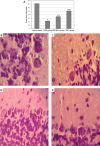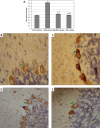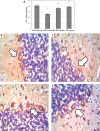Adipose tissue-derived mesenchymal stem cells have better restorative capacity than bone marrow-derived cells in a cerebellar ataxic rat model
- PMID: 40190306
- PMCID: PMC11969554
- DOI: 10.5114/aoms.2020.100833
Adipose tissue-derived mesenchymal stem cells have better restorative capacity than bone marrow-derived cells in a cerebellar ataxic rat model
Abstract
Introduction: Regenerative treatment using stem cells represents a potentially effective therapy for cerebellar ataxia (CA). We compared the therapeutic potential of adipose tissue stem cells (ASCs) and bone marrow mesenchymal stem cells (BM-MSCs) in a rodent monosodium glutamate (MSG)-induced CA cell (BM-MSC) model.
Material and methods: Female Wistar rats (n = 40) were equally divided into a saline-treated control group and 3 MSG-induced CA groups randomly treated with either saline, or 1 × 106 ASCs or BM-MSCs. We assessed the following: 1) cerebellar motor functions in vivo (by Rotarod test, open-field test, and Quantitative gait analysis); 2) cerebellar histological architecture; and 3) cerebellar immunohistochemical examination of the Bax/Bcl-2 ratio as in indicator of apoptosis, and the levels of vascular endothelial growth factor (VEGF) and insulin-like growth factor-1 (IGF-1) as neuroprotective factors.
Results: Treatment with either of the MSCs improved MSG-induced poor motor performance, restored the disrupted Purkinje cell layer, decreased neuronal apoptosis and enhanced cerebellar VEGF and IGF-1 levels observed in CA rats. Adipose tissue stem cells showed superiority over BM-MSCs in the improvement of some motor performance parameters and cerebellar VEGF and IGF-1 levels.
Conclusions: In conclusion, both stem cell types induced structural, physiological, and biochemical improvement, with ASCs being best for treatment of CA.
Keywords: Purkinje cells; adipose tissue stem cells; bone marrow mesenchymal stem cells; cerebellar ataxia; monosodium glutamate.
Copyright: © 2020 Termedia & Banach.
Conflict of interest statement
The authors declare no conflict of interest.
Figures









Similar articles
-
Therapeutic role of adipose tissue-derived stem cells versus microvesicles in a rat model of cerebellar injury.J Cell Mol Med. 2022 Jan;26(2):326-342. doi: 10.1111/jcmm.17083. Epub 2021 Dec 7. J Cell Mol Med. 2022. PMID: 34874117 Free PMC article.
-
Comparison between the Regenerative and Therapeutic Impacts of Bone Marrow Mesenchymal Stem Cells and Adipose Mesenchymal Stem Cells Pre-Treated with Melatonin on Liver Fibrosis.Biomolecules. 2024 Mar 1;14(3):297. doi: 10.3390/biom14030297. Biomolecules. 2024. PMID: 38540717 Free PMC article.
-
Adipose Stem Cells Display Higher Regenerative Capacities and More Adaptable Electro-Kinetic Properties Compared to Bone Marrow-Derived Mesenchymal Stromal Cells.Sci Rep. 2016 Nov 24;6:37801. doi: 10.1038/srep37801. Sci Rep. 2016. PMID: 27883074 Free PMC article.
-
Same or not the same? Comparison of adipose tissue-derived versus bone marrow-derived mesenchymal stem and stromal cells.Stem Cells Dev. 2012 Sep 20;21(14):2724-52. doi: 10.1089/scd.2011.0722. Epub 2012 May 9. Stem Cells Dev. 2012. PMID: 22468918 Review.
-
Regenerative medicine strategies for hair growth and regeneration: A narrative review of literature.Regen Ther. 2022 Oct 31;21:527-539. doi: 10.1016/j.reth.2022.10.005. eCollection 2022 Dec. Regen Ther. 2022. PMID: 36382136 Free PMC article. Review.
References
-
- Reimers D, Osuna C, Gonzalo-Gobernado R, et al. . Liver growth factor promotes the survival of grafted neural stem cells in a rat model of Parkinson’s disease. Curr Stem Cell Res Ther 2012; 7: 15–25. - PubMed
-
- Pittenger MF, Mackay AM, Beck SC, et al. . Multilineage potential of adult human mesenchymal stem cells. Science 1999; 284: 143–7. - PubMed
LinkOut - more resources
Full Text Sources
Research Materials
Miscellaneous
